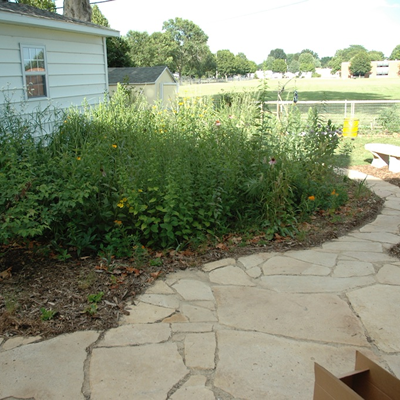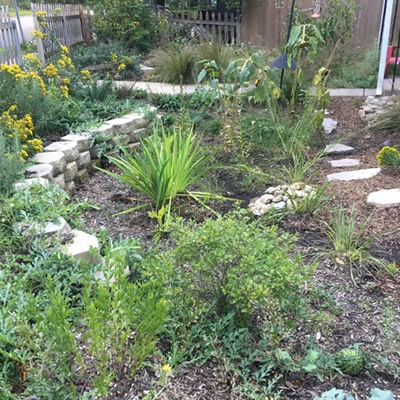Rain Water Management
Paradigm Shift in Water Flow
Historically, nearly all rain water infiltrated into the ground where it landed. Trees, shrubs, grasses and wildflowers captured and slowed rain water so that it could slowly drip and percolate down to the soil surface. A rich layer of organic matter was able to absorb rain water, even from heavy storms.
Today hard surfaces such as roads, roofs, and even lawns force water to flow over the surface. We're left with streams that suffer from dramatic flood pulses and warmer, polluted and nutrient laden lakes. Meanwhile, even here in the midwest our groundwater stores are being depleted since we are drawing from them faster than they can be recharged.
In the 19th Century, Lake Mendota and Lake Monona in Madison, Wisconsin were a vacation destination for big city dwellers seeking clean, crystal-clear, rejuvenating waters. Today the waters are so polluted that the beaches are often closed to swimming in the summer.
We can help reverse this trend so we can live in a landscape and enjoy clean, safe water. Here are a few strategies Good Oak can employ at your home, business or neighborhood.


Rain Gardens and Bio-Retention Basins
Retaining water on-site is a important aspect of every landscape design we produce. Rain gardens are a landscape feature specifically designed to capture rain water from roofs and other hard surfaces and infiltrate it into the ground. These native gardens are not water features, they remain dry most of the time We design each based on how much water flows into them and the soil type of the site to infiltrate this water in the minutes or hours following a rain storm. Once in the garden, the deep roots of native plants help absorb, clean and percolate the water deep into the soil and eventually down to groundwater reserves. This keeps the water, and the lawn chemicals, petroleum products, silt and other pollutants this has collected after running over urban surfaces, out of our storm water system and out of our water ways.
Bio-retention basins are much like large rain gardens, places where water is collected from nearby non-permeable surfaces likes roofs or parking lots, and are more typical of commercial properties. They need to be designed more robustly than your typical rain garden so that they can handle the volume and speed of water that enters them.


Bioswale
Bioswales are essentially ditches, with a very notable difference. Most ditches are designed with relatively steep grades to move water off of a site quickly. Bioswales are designed with broad bottoms and shallow grades and are vegetated with native plants. The water is meant to move slowly and gently through a bioswale so that much of it can be absorbed and pollutants and silt can be filtered out by the deep roots of the native plants before the water moves off-site.
Shoreline Restoration
Shoreline restoration projects can stabilize shorelines to prevent erosion, and reestablish healthy shoreline habitat. Shoreline buffer plantings can act as the last line of defense to prevent dirty, warm water from entering our lakes and s streams. See our shoreline restoration page for more information.
Permeable Hardscaping
Whether you're repairing your patio, walkway, or driveway or installing a new one there are many material options that are more attractive and water-permeable than concrete, asphalt or traditional brick. We prefer to work with locally sourced limestone for walkways, walls, patios and stepping stones. For driveways we are excited about the possibilities of permeable pavers. If you're trying to save money as well as the environment, a carefully designed and installed gravel and crushed stone surface can be both low-cost and attractive.


Rain Water Storage
Rain barrels and cisterns are a great way to capture rain water for re-use. We are experienced in designing landscapes incorporating these features and installing them for you.


Green Roof
A green root can be the first line of defense to capture rain water right where it falls. Extensive green roofs can be retrofitted to many existing buildings since they have shallow soil beds and little or no irrigation equipment installed. There is no need for boring sedums - we have selected a group of native plants from habitats like sand barrens, bedrock prairies and lakeshore dunes which are ideally suited for the shallow soils of an extensive green roof. These plants can thrive in this harsh environment and provide interest as well as habitat and resources for butterflies, bees, birds and other beneficial wildlife.

